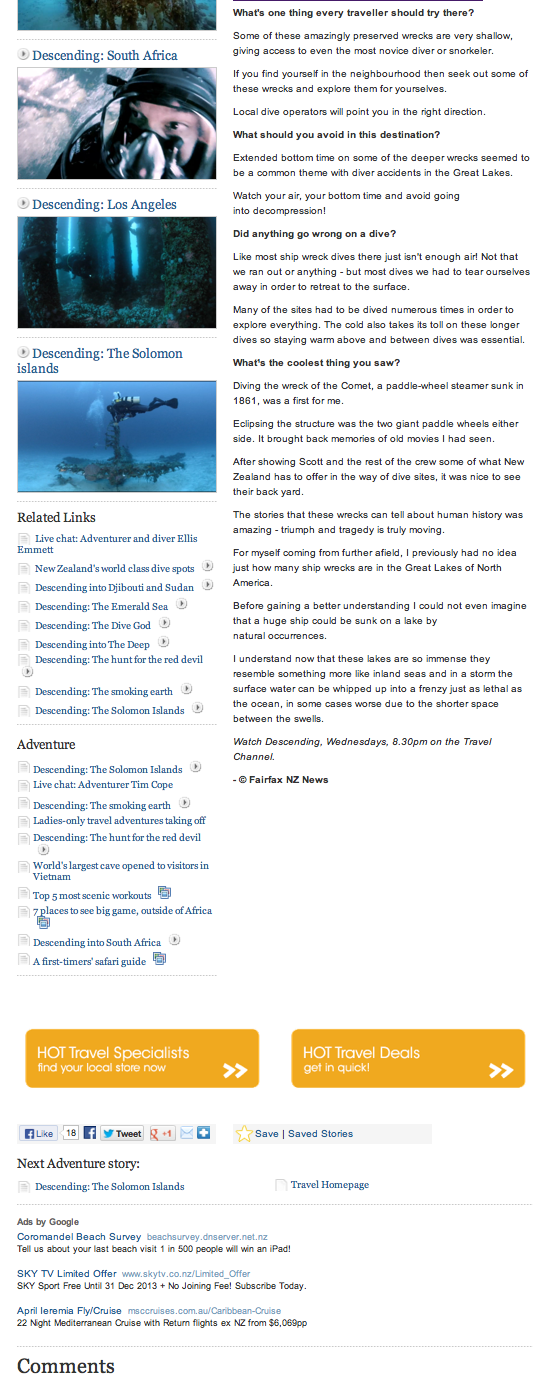
Descending: The Great Lakes
Published on Wednesday, October 23rd, 2013, under Media
click on the photo above to watch the video footage
Canadian Scott Wilson and Kiwi Ellis Emmett have been where no men have been before.
An 18 month trip took them to some of the world’s remotest dive locations – many of which have only recently been discovered.
Scott and Ellis chronicle these travels as co-hosts of a show, Descending on the Travel Channel. We’ll catch up with them each week about the destinations they’ve been to.
For centuries, the St. Lawrence Seaway and the Great Lakes have shaped the story of Canada. The team takes a trip through history and visits the world’s best collection of freshwater shipwrecks to discover what makes this water so great.
We chat to Ellis about this incredible experience.
What was your favourite dive from this episode?
Diving the wreck of the Arabia is going to be hard to beat. It’s a 127 year old wooden ship thickly cloaked in history.
Exploring this incredible wreck made me feel like I was diving an ancient pirate ship.
The character of these wooden ships speaks to a bygone era that we will never see the likes of again. It’s better than any museum I’ve ever been!
How did you get there?
From the outskirts of Toronto we simply drove the 300kms up to Tobermory.
For the rest of the crew, being Canadian, it was one of the closest dive locations that we explored while filming the series.
What diving risks were you concerned about in this location?
The Arabia, at 120ft, is not that deep as far as wrecks go, but coupled with the sometimes low visibility, the intense cold temperature of the lake water and the mesmerizing nature of this ship wreck it has claimed a startling number of divers lives.
This concerned and puzzled us before we dived the wreck. Once down there we too became captured by her beauty and could see how easily one could be caught off guard and stay a little too long.
What’s one thing every traveller should try there?
Some of these amazingly preserved wrecks are very shallow, giving access to even the most novice diver or snorkeler.
If you find yourself in the neighbourhood then seek out some of these wrecks and explore them for yourselves.
Local dive operators will point you in the right direction.
What should you avoid in this destination?
Extended bottom time on some of the deeper wrecks seemed to be a common theme with diver accidents in the Great Lakes.
Watch your air, your bottom time and avoid going into decompression!
Did anything go wrong on a dive?
Like most ship wreck dives there just isn’t enough air! Not that we ran out or anything – but most dives we had to tear ourselves away in order to retreat to the surface.
Many of the sites had to be dived numerous times in order to explore everything. The cold also takes its toll on these longer dives so staying warm above and between dives was essential.
What’s the coolest thing you saw?
Diving the wreck of the Comet, a paddle-wheel steamer sunk in 1861, was a first for me.
Eclipsing the structure was the two giant paddle wheels either side. It brought back memories of old movies I had seen.
After showing Scott and the rest of the crew some of what New Zealand has to offer in the way of dive sites, it was nice to see their back yard.
The stories that these wrecks can tell about human history was amazing – triumph and tragedy is truly moving.
For myself coming from further afield, I previously had no idea just how many ship wrecks are in the Great Lakes of North America.
Before gaining a better understanding I could not even imagine that a huge ship could be sunk on a lake by natural occurrences.
I understand now that these lakes are so immense they resemble something more like inland seas and in a storm the surface water can be whipped up into a frenzy just as lethal as the ocean, in some cases worse due to the shorter space between the swells.
Watch Descending, Wednesdays, 8.30pm on the Travel Channel.
– © Fairfax NZ News
http://www.stuff.co.nz/travel/themes/adventure/9316154/Descending-The-Great-Lakes







